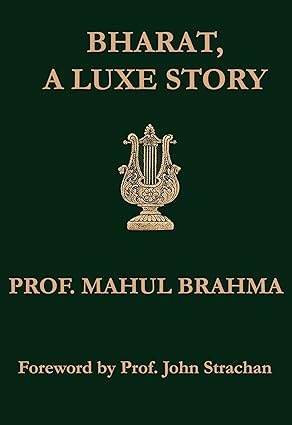Bharat, A Luxe Story by Dr Mahul Brahma
My take on the book:
In Bharat, A Luxe Story author Dr Mahul Brahma narrates the story of India in the Luxury products sector, as a compilation of essays recollecting the lectures the author delivered in the past. The author begins with how luxury was flaunted by the Rajas and Maharajas during the British rule of India, how luxury was mostly a means of satisfying the ego for these rulers.
In the next chapter, the author explains the various kinds of consumers of luxury — Flaunters, Connoisseurs, Aesthetes and Experientialists. The author further explains these four types of consumers and the kinds of products they bought and how they are categorized accordingly.
The next chapter is dedicated to the great aspiring middle class who are slowly becoming the main target consumers for the luxury brands in the recent years; the masses with limited means. In the fourth chapter, the author explains the concept of Quiet Luxury and how characteristics of quiet luxury contradict with the concepts of luxury itself. The author also puts forth communication methods for quiet luxury.
The sixth chapter explains aesthetic luxury and communication strategies for same. The rules for creating luxe aura are also explained and then the author examines what mistakes are pulling down the Asia Strategy contrasting between India and China as Luxury markets. What is the USP for luxury products, what attracts consumers to these luxury products and which approach do the brands use is explained.
Luxury cannot be discussed without examining how multi-million-dollar worth wedding industry thrives in India. The author also explains how brands should make the wait worthy for its consumers, especially when products garner stupendous demand but then they quickly go out of stock and the wait time builds up into weeks and months.
The concept of a luxury brand means what image it conjures up for its consumer just by the mere mention of the brand’s name. Controversary around luxury brands are a common phenomenon and the author recounts some of the most interesting and intriguing controversaries faced by luxury brands.
Luxury brand also means longevity and brand legacy and the author puts forth the steps that brands need to implement to take forward their legacy. The final chapters deal with the uncomfortable but important topics of counterfeit products and what makes a fake luxury more desirable and in demand. The author concludes the book by explaining how value of luxury can be calculated.
I read the earlier books of the author around the same topic of Luxury products — Quite Luxe and Aesthetic Leadership in Luxury . Interestingly this book has snippets and references from the earlier books so the initial chapters felt bit redundant and boring for me. However, once past the first few chapters the author brings in more concepts of luxury which will make the reader sit up and take notice.
Like the earlier works, this book is also well researched, and the author makes the topic easy for reader by explaining the concepts in lucid language with relatable examples. The author brings in a multitude of topics to Demystify luxury, as the book traces the evolution of luxury in India from its ancient roots to the modern era, highlighting the changing tastes and preferences of Indian consumers.
The book discusses the move away from loud luxury towards a more quiet and personalized approach, where experiences and craftsmanship hold greater value than ostentatious displays of wealth. The book also explores how luxury is becoming more accessible to a wider range of consumers in India, with the rise of contemporary brands and experiences catering to diverse tastes and budgets.
Overall, the book offers a thought-provoking and insightful look at the multifaceted world of luxury in India. It is a valuable resource for anyone interested in understanding the cultural and economic significance of luxury in our national context.
My rating:
4/5.
